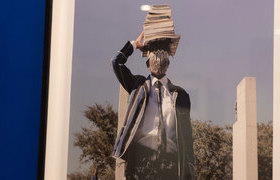UCT art collection: more than décor
27 October 2025 | Story and Photo Justin Keep. Read time 8 min.
Students spend a lot of time on campus wondering what they should be doing. Luckily, the University of Cape Town (UCT) supplies lots of art to catch the eye in times of boredom.
The university’s collections, from contemporary pieces to historical works, reflect a living dialogue between creativity, identity and the pursuit of knowledge.
One collection is particularly eye-catching. Well, its eyes catch you: Cape Town photographer Haneem Christian’s Memorial Ball photo set, which commemorates Kirvan Fortuin. Fortuin, a local drag mother and founder of the internationally recognised House of le Cap, was a ballroom and queer icon. Christian said of their photography, “I am not here to take”, and these images really feel like that: a family portrait given to a loved one.
The central image of the set shows all the members of the House of le Cap, Fortuin’s family, gathered around an image of Fortuin adorned with a sash reading “Mother of the Year”. A statement by the Artscape Theatre on Fortuin’s death described how they never failed to recognise “the inherent dignity of the queer child; the trans child; the forgotten child”. One can see Fortuin in each member: the tilt of a head, raise of an eyebrow or placement of a hand. This family looks out through the glass as you pass.
The veiled eye
Another eye is found in a pair of photographs at the crest of the stairs leaving the Otto Beit Building. It gazes out from “Untitled IV” by Nigerian artist Lakin Ogunbanwo, an image of a Nigerian bride in traditional ceremonial wear. Swathes of fabric and veils of silk pass across her as she sits beside her numeric predecessor, “Untitled III”. She looks out at those climbing past from behind the pearls scattered across her clothes like stars.
Ogunbanwo’s intention with this collection of photos, called “e wá wo mi” (come look at me) was to show the burden of duty that marriage carries for Nigerian women. The aim was to capture the intricate layers of Nigerian bridal cultures, ones of identity as well as clothing. As Ogunbanwo stated at an exhibition, they set out to trouble “the idea that there is only one way to get married or that Nigerian culture is only one thing”. Through the layers of cloth upon them, the brides sit tall with eyes fixed forward and hands placed precisely. They pierce through those interweaving, intersecting layers to reach out and grab one from across the steps they watch over.
Looking closer
Similar interweaving layers are found on the first floor of the New Neville Alexander Building in a woven piece by Congolese artist Maurice Mbikayi. From afar, “Voices” looks relatively simple: a multi-coloured tapestry stretched across a wooden frame. It’s only as the eyes drift to the bottom of it that the plugs on the ends of each strand are revealed. The entire thing is made from electronic cables.
Mbikayi has made several pieces in this style, weaving the cables one finds tangled so often into statements on the environmental cost of the digital world. Mbikayi has described it as “the underbelly of advancement”. He explores how much we discard from ‘non-physical’ endeavours and shows a way in which those discarded pieces can be reused. In this way, he comments on the resilience of ‘discarded’ peoples: “My work celebrates this ingenuity and persistence of spirit, depicting figures who have created radical new approaches to reinvention and change.” Feeling across the twists of plastic, one considers where all the cables that line the walls, floors and devices around us will end up.
Seeing yourself looking back
Like in “Voices”, tapestries encourage following each strand as it makes its way across the piece, touching and relying on all others around it. This is best illustrated in Igshaan Adams’ piece in the New Lecture Theatre; a gold-green-red-orange tapestry covered in tassels near the main lecture hall. This piece comes from Adams’ Desire Lines exhibition, emphasising the “material aspects of lived spaces along with the personal stories held within them” through textured tapestry.
“I was a hidden treasure, then I wanted to be known”, acquires a name from a translation of a hadith qudsi; words of the prophet Muhammad that speak of humankind’s divine creation. As much as Allah created humans to be manifestations and recognitions of God, we also give each other purpose through recognition of others. We all have, as Adams describes, “the deep desire for each of us to be known and seen”.
“The piece asks one to see how each piece of fabric is connected. It serves to remind me that we’re a little part of something much larger, in a comforting way.”
 This work is licensed under a Creative Commons Attribution-NoDerivatives 4.0 International License.
This work is licensed under a Creative Commons Attribution-NoDerivatives 4.0 International License.
Please view the republishing articles page for more information.



















